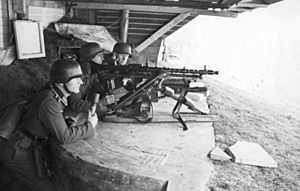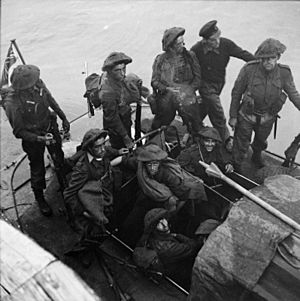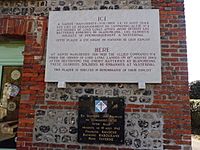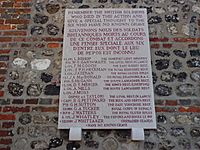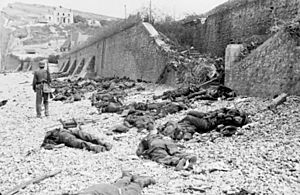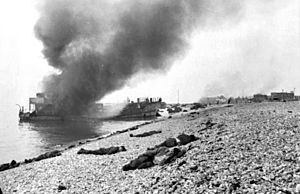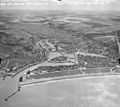Dieppe Raid facts for kids
Quick facts for kids Dieppe Raid |
|||||||
|---|---|---|---|---|---|---|---|
| Part of the North West Europe Campaign | |||||||
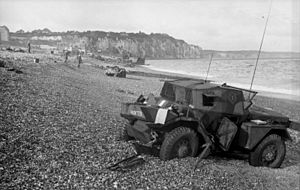 Dieppe's chert beach and cliff immediately following the raid on 19 August 1942. A Dingo Scout Car has been abandoned. |
|||||||
|
|||||||
| Belligerents | |||||||
| Commanders and leaders | |||||||
| Strength | |||||||
|
Infantry
Royal Navy Royal Air Force |
302nd Static Infantry Division ~1,500 men Does not include Luftwaffe and Kriegsmarine |
||||||
| Casualties and losses | |||||||
| Ground forces Canada: 907 killed, 586 wounded, 1,946 captured United Kingdom: 275 commandos Royal Navy 1 destroyer 33 landing craft 550 dead and wounded Royal Air Force 64 Supermarine Spitfire fighters 20 Hawker Hurricane fighters 6 Douglas Boston bombers 10 North American Mustang Mk 1 fighters 62 killed, 30 wounded, 17 captured |
Ground forces Germany: 311 dead, 280 wounded Luftwaffe 23 Fw 190 25 Dornier Do 217 |
||||||
The Dieppe Raid was a major attack during World War II. It was also called the Battle of Dieppe or Operation Jubilee. On August 19, 1942, the Allied forces attacked the port of Dieppe in France. This port was controlled by Germany at the time.
The attack started early in the morning at 5:00 a.m. By 10:50 a.m., the Allied leaders had to order a retreat. More than 6,000 soldiers, mostly from Canada, took part. They had help from Canadian tanks, the British Royal Navy (sea forces), and a smaller group from the Royal Air Force (air forces).
The main goals of the raid were to capture a major port for a short time and to gather important information. The Allies also wanted to destroy German defenses, port buildings, and other important structures before leaving. Another goal was to boost morale and show that the United Kingdom was serious about opening a new front in Europe.
Sadly, none of these main goals were achieved. The Allied troops did not have enough artillery support. They got stuck on the beach because of obstacles and heavy German gunfire. Less than 10 hours after the first landings, all the Allied troops were either killed, evacuated, or captured by the Germans.
Instead of showing strength, the high number of Allied deaths proved that the Allies were not ready to invade France for a long time. However, the attack did help the Allies gather some useful information.
Out of 6,086 men who landed, 3,623 (almost 60%) were killed, wounded, or captured. The Royal Air Force tried to draw the German air force, called the Luftwaffe, into a big battle. But the RAF lost 96 aircraft, while the Luftwaffe lost 48. The Royal Navy also lost 33 landing craft and one destroyer. The lessons learned from Dieppe helped shape the plans for later invasions, like the one in North Africa (Operation Torch) and the Normandy landings (Operation Overlord).
Why the Dieppe Raid Happened
The British decided to plan the Dieppe attack quickly, within a month. They kept the plans very secret, so few records were made.
After British soldiers had to leave Dunkirk in May 1940, the British started planning how to attack by landing troops from ships onto beaches. This is called amphibious warfare.
The British wanted to see if they could capture a port. This would let them test how to use ships in an attack. It would also help them test new military equipment.
Dieppe is a town on the coast of France, built along a cliff by the English Channel. In 1942, the Germans had placed two large artillery batteries (groups of big guns) nearby. A key reason Dieppe was chosen was that it was close enough for the Royal Air Force's fighter planes to reach.
There was also pressure from the Soviet Union to attack Germany in Western Europe. By early 1942, Germany's attack on the Soviet Union, called Operation Barbarossa, had not destroyed the Soviets.
However, German forces were moving deeper into Soviet territory, pushing towards Stalingrad. The Soviet leader, Joseph Stalin, demanded that the Allies attack France. He hoped this would force Germany to move 40 divisions of soldiers away from the Eastern Front, making it easier for the Soviet Red Army.
Planning the Attack
The Dieppe raid was a big attack planned by Lord Mountbatten.
The attacking force would include about 5,000 Canadian soldiers, 1,000 British troops, and 50 American Rangers.
The plan was first made in April 1942 and was called Operation Rutter. The Allies planned to attack a German-held port on the French coast. They would hold it for two tides, destroy enemy buildings and defenses, and then leave.
This plan was approved in May 1942. It first included British paratroopers attacking German artillery batteries. But the parachute part was cancelled. Instead, special forces called No. 3 Commando and No. 4 Commando would land by sea to attack the big guns.
Soldiers on the Ground
The Canadian government wanted its troops to take part in the fighting. So, the 2nd Canadian Infantry Division, led by Major General John Hamilton Roberts, was chosen for the main attack force.
The plan called for an attack without heavy air bombing.
The lack of enough bombing was one of the main reasons the attack failed. Some people believe that air and naval bombing was limited to avoid hurting French civilians in the port.
The landings at Dieppe were planned for six beaches. Four were in front of the town, and two were on the eastern and western sides.
Tanks were also used to support the attack. The 14th Army Tank Regiment brought 58 new Churchill tanks. These tanks would be brought ashore using new landing craft tanks (LCT). Some of the Churchills even had flame-throwers. All of them could work in the shallow water near the beach.
The Royal Navy was supposed to provide 237 ships and landing craft. However, there was only limited naval gunfire support before the landings. This came from six destroyers with 4-inch guns. The Royal Air Force would provide 74 squadrons of aircraft, mostly fighter planes.
Gathering Information
There was not much information about the beaches. German gun positions on the cliffs had not been spotted. The planners thought that Dieppe was not heavily defended. They also believed the beaches were good for landing soldiers and tanks.
German Forces
The German forces at Dieppe were ready for the attack. They had been warned by French double agents that the British were planning something in the area. They had also noticed more radio chatter and landing craft gathering in British ports.
Dieppe and its cliffs were very well defended. About 1,500 German troops were placed along the beaches of Dieppe and nearby towns. They covered all the likely landing spots.
The Germans had many machine guns, mortars, and artillery (big guns). The city and port were strongly protected.
The German air force, the Luftwaffe, had two fighter groups, Jagdgeschwader 2 (JG2) and Jagdgeschwader 26 (JG26). They had 200 fighter planes, mostly Fw 190s. There were also about 100 bombers, mostly Dornier 217s.
First Landings
The Allied ships left the south coast of England on the night of August 18, 1942. The Canadian ships left from the Port of Newhaven. Eight destroyers and other small boats protected the landing craft. Minesweepers went ahead to clear paths through the English Channel.
The first landings began at 4:50 a.m. on August 19. Attacks were planned for two German artillery batteries on the sides of the main landing area.
On their way in, the landing craft heading towards Puys and Berneval met a small group of German ships. They exchanged fire at 3:48 a.m.
Yellow Beach
The goal for Lieutenant Colonel John Durnford-Slater and No. 3 Commando was to land about 8 miles east of Dieppe. They were to destroy the coastal artillery battery near Berneval. This battery could fire on the main landing at Dieppe.
The boats carrying No. 3 Commando approached the coast. They were not warned about a German convoy that British radar had found earlier.
German S-boats (small, fast attack boats) protecting a German tanker fired torpedoes. They hit some landing craft and damaged a British escort boat.
Other British boats fired back at the German ships. The group of landing craft got spread out, and some were lost. This also alerted the German defenses on the coast.
Only 18 commandos got close to the German artillery battery. They fired their guns at the Germans. Even though they couldn't destroy the artillery, they caused problems for the German gun crews. The commandos had to pull back because there were too many enemy troops.
Orange Beach
The goal for Lord Lovat and No. 4 Commando (which included 50 American United States Army Rangers) was to land about 6 miles west of Dieppe. They had to destroy the German artillery battery called Hess at Blancmesnil-Sainte-Marguerite. They landed on the right side, climbed the hill, and attacked. They successfully destroyed the artillery battery, which had six 150 mm guns. This was the only real success of Operation Jubilee. The commandos then left at 7:30 a.m. as planned.
Most of No. 4 Commando returned to England. This part of the raid was seen as a good example of how special forces should attack during landings. Lord Lovat received the Distinguished Service Order, and Captain Patrick Porteous of No. 4 Commando received the Victoria Cross.
Blue Beach
The fight between the small German convoy and the boats carrying No. 3 Commando had warned the German defenders at Blue beach. The landing near Puys by the Royal Regiment of Canada and some other troops was supposed to destroy machine gun and artillery batteries protecting Dieppe beach.
Their landing was delayed by 20 minutes. The smoke that was supposed to hide their attack had cleared. The Germans were ready in their strong defensive positions when the landings began. The well-protected German forces fired heavily at the Canadian soldiers who landed on the beach.
As soon as they reached the shore, the Canadians could not move forward. The Royal Regiment of Canada suffered many deaths. Out of 556 men in the regiment, 200 were killed and 264 were captured.
Green Beach
At Green beach, at the same time No. 4 Commando landed, the South Saskatchewan Regiment went towards Pourville. They landed at 4:52 a.m. without being noticed. The regiment managed to get off their landing craft before the Germans could start firing.
The regiment needed to enter Pourville to cross the river using the only bridge. Before they could reach the bridge, the Germans had set up machine guns and anti-tank guns there, which stopped them. With dead and wounded Canadians on the bridge, Lieutenant Colonel Charles Cecil Ingersoll Merritt, the commanding officer, crossed the bridge several times. He wanted to show his soldiers that the bridge could be crossed. Lieutenant Colonel Merritt was awarded the Victoria Cross.
Pourville Radar Station
One of the goals of the Dieppe Raid was to learn about the technology of a German radar station.
RAF Flight Sergeant Jack Nissenthall, who was a radar expert, was supposed to try and enter the radar station to learn its secrets. If he was about to be captured, the soldiers with him were ordered to kill him. He knew many secrets about Allied radar. He also carried a cyanide pill to take if he was captured.
Nissenthall and his men could not get into the radar station because of strong German defenses. However, Nissenthall did manage to cut all the telephone wires, which was helpful.
Images for kids
-
Dieppe is in the département of Seine-Maritime, in Normandy
See also
 In Spanish: Batalla de Dieppe para niños
In Spanish: Batalla de Dieppe para niños



